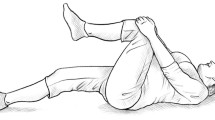Summary
This study was done to evaluate a new, simple, non-invasive pain provocation test as an aid to differentiate between low-back and posterior pelvic pain in pregnant women. The test was performed on 72 pregnant women at various stages of pregnancy with or without low-back or posterior pelvic pain. The study was conducted by two physiotherapists with special interest in back pain in pregnancy at a normal antenatal clinic. The test was easy to learn, perform and interpret and was applicable throughout pregnancy. There was a strong correlation between a positive test answer and a history of posterior pelvic pain (P < 0.01, chi-square). There were no side-effects. The test was highly specific and had a high positive prediction value for posterior pelvic pain and a high negative prediction value for low-back pain among pregnant women.
Similar content being viewed by others
References
Abrahamson D, Roberts SM, Wilson PD (1934) Relaxation of the pelvic joints in pregnancy. Surg Gynecol Obstet 58:595–613
Bernard TN Jr, Cassidy JD (1992) The sacroiliac joint syndrome, pathophysiology, diagnosis and management. In: Vleeming A et al (eds) First Interdisciplinary Worl Congress on Low Back Pain and Its Relation to the Sacroiliac Joint, San Diego, November 5-6. ECO, Rotterdam, pp 119–143
Bernard TN Jr, Kirkaldy-Willis WH (1987) Recognizing specific characteristics of non-specific low back pain. Clin Orthop 217:266–280
Fast A, Shapiro D, Ducommon E, Friedman L, Bouklas T, Floman Y (1990) Low-back pain in pregnancy. Spine 4:368–371
Hansen JH (1992) The clinical influence of dysfunction of the sacroiliac joint and the articulation in peripartum women. In: Vleeming A et al. (eds) First Interdisciplinary World Congress on Low Back Pain and Its Relation to the Sacroiliac Joint, San Diego, November 5-6. ECO, Rotterdam, pp 175–177
Mantle MJ, Greenwood RM, Currey HLF (1977) Backache in pregnancy. Rheumatol Rehabil 16:95–101
McLennan A, Green R, Nicolson R, Bath M (1986) Serum relaxin and pelvic pain of pregnancy. Lancet 2:241–243
Östgaard HC, Andersson GBJ, Karlsson K (1991) Prevalence of back pain in pregnancy. Spine 5:549–552
Östgaard HC, Zetherström G, Roos-Hansson E (1994) Reduction of back and posterior pelvic pain in relation to pregnancy. Spine 19:894–900
Potter NA, Rothstein J (1985) Inter-tester reliability for selected clinical tests of the sacroiliac joint. Physiotherapy 11:1671–1675
Sturesson B, Selvik G, Udèn A (1989) Movements of the sacroiliac joints. A roentgen stereophotogrammetric analysis. Spine 14:162–165
Walde J (1962) Obstetrical and gynecological back and pelvic pains, especially those contracted during pregnancy. Acta Obstet Gynecol Scand Suppl 2:1–52
Young J (1940) Relaxation of the pelvic joints in pregnancy. J Obstet Gynaecol Br Empire 5:493–523
Author information
Authors and Affiliations
Rights and permissions
About this article
Cite this article
Östgaard, H.C., Zetherström, G. & Roos-Hansson, E. The posterior pelvic pain provocation test in pregnant women. Eur Spine J 3, 258–260 (1994). https://doi.org/10.1007/BF02226575
Issue Date:
DOI: https://doi.org/10.1007/BF02226575




